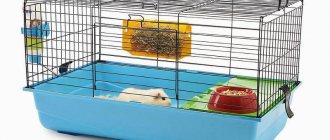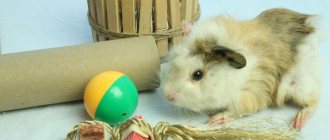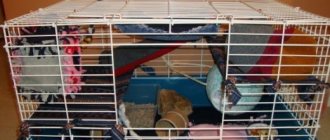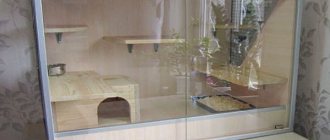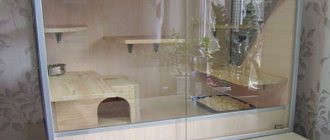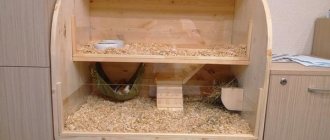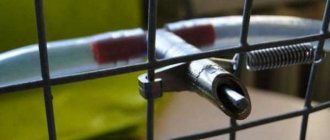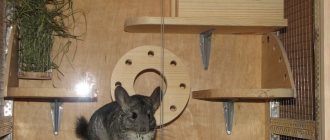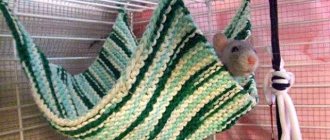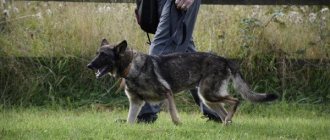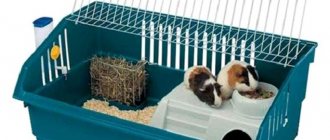The life of a rodent in a cage is not very diverse. Therefore, using devices to entertain your pet will benefit his mood and health. One such device is a guinea pig hammock. It acts as a soft and comfortable shelf for relaxation. But in order to get into it, the pet will have to make some efforts, which will have a good effect on its physical form.
Walking outside and at home
Outdoor walks are organized subject to the following conditions:
- Choose a secluded place where there are no animals or people.
- Enclose the play area using an aviary or other devices. Or use a harness and leash.
- Go out only in warm, dry weather. If during the morning walk the dew has not yet left the grass, blot it with a paper towel.
While on the street, the pig requires constant supervision because it is in a high-risk area. Before leaving the house, you should apply an anti-parasite spray to the fur so that the animal does not bring ticks or fleas from the street.
The walk lasts about an hour or until the animal shows signs of fatigue: it reduces activity, stops playing, or sits motionless.
How to make it yourself?
It is not necessary to purchase a ready-made hammock for your pet at a pet store. Store-bought products are not always of good quality and reasonable price. From available materials you can make a good and reliable model of the required size. During production, a number of recommendations should be taken into account.
- There is no need to try to save free space in the cage and make a bed that is too compact. It is better if the hammock is 2 or more times wider than a rodent.
- It is best to use metal objects, such as paper clips and chains, as fasteners for the product. Such fastenings will be more reliable than a simple rope, which a rat can easily chew through.
- The fabric from which the hammock will be made must not only be durable, but also safe from a toxic point of view. If it was painted with harmful dyes, then the pet may get poisoned. It is best to use natural types of fabrics rather than synthetics.
- Metal parts can only be used as fasteners, but not as the main canvas for the bed. A metal mesh is stronger than fabric; an animal is unlikely to chew through it and ruin it, but it can injure the pet. In addition, metal is too hard and cold material, so the rodent will be uncomfortable and uncomfortable on such a hammock.
From jeans
Using old denim clothes is one of the easiest ways to make a hammock for rats. In this case, you don’t even need to pick up a needle, thread and sew. All you need to make a hammock is:
- unnecessary jeans;
- stationery scissors;
- ruler or measuring tape;
- a small piece of old soap;
- metal chain or paper clips.
It will take no more than 10 minutes to make a denim bed. It is best to use old wide men's jeans. You need to measure 25 centimeters from the bottom edge of the trouser leg and mark the cut with a bar of soap. Then you need to cut a piece from the trouser leg and start making fasteners.
The number of staples in the chain will depend on the height at which you plan to hang the hammock. The materials used must be quite strong so that the fasteners can withstand the weight of the decorative rat. Chains or staples are threaded through one layer of jeans at the four corners of the cut piece. After this, you can place the bed in the cage and attach it to the metal bars. The rodent can be placed on the lounger either on top or inside the trouser leg itself.
Place to rest
Making a hammock for a cat, chinchilla, rat, pig or degu with your own hands is quite simple. But before you get to work, it’s worth considering some of the characteristics of each animal, and most importantly, why they need a hammock.
The most comfortable place for a cat to sleep is soft and safe. Domestic felines love to sleep on chairs, on pillows, and on warm and soft things. At the same time, cats choose places for rest and sleep, as a rule, narrow and dark. That is why a hammock can be an ideal place to relax, especially if you place it in “secret” and warm places: under a chair, near a radiator, in the corners of the room.
Read this: Fruits from candies: secrets of beautiful packaging
A simple hammock for a cat can be made from the following materials:
- felt;
- ribbon;
- Velcro or ribbons for fastening;
- sewing machine;
- soft pencil;
- threads and needles.
How to do:
Cut out a square or rectangular bed from felt according to the required size;
Try on the tape along the edges of the felt, leaving large loops at the ends;
Brush the decorative tape along the edge to cover the edges (for convenience, you can press the tape with paper clips);
Sew the ribbon to the felt using a machine;
Cut the loops at the corners, solder the edges with a lighter and sew Velcro on them;
Secure the finished hammock in the desired place.
It is convenient to place such a hammock under a chair - no one will disturb the cat there.
Here are some more cat hammock ideas:
You can also try to design a hammock chair similar to a real one for your pet. It can be made in different ways - sewn from fabric, woven from rope or made using a frame. Such a hammock will surely appeal not only to the cat, but also to its owner.
Ferrets also love to climb into hammocks and sleep there. For a ferret, you can make a multi-level hammock, which the animal can use not only for sleeping, but also for playing. To do this you will need fabric, a sewing machine, needles, threads and ribbons or strong ribbons.
Read this: DIY Shibori: A Fun Pastime for Everyone
The fabric must be selected taking into account the weight and character of the animal. The hammock, like the attachments, must support the weight of the ferret, and also be strong enough for its teeth (you can sew several layers of fabric). Of course, it is better to make a choice towards natural fabrics and materials (cotton, felt, wool, etc.).
It is proposed to make a hammock according to one of the pattern diagrams below:
For a chinchilla, you can sew a hammock in the form of a tube from old jeans. This model can be hung from the ceiling of the cage. To make a hammock you need to prepare:
- old jeans or denim;
- thread and needle;
- scissors;
- tape;
- eyelets (4 pcs.);
- carabiners or other fastening.
How to sew a hammock:
Fold the double fabric in half, baste and sew the edges together either by machine or by hand to form a tube;
Seal the edges with tape in a circle on each side;
Cut round holes and insert grommets;
Using carabiners or passing ribbons through the holes, hang the tube hammock in the cage.
Read this: DIY clothes dryer made from special pipes
Ready!
For a multi-level hammock, each level is cut out and processed separately. Several pieces of rectangular or square shape are sewn together. You need to sew ribbons to the corners. Small carabiners can be attached to the ends of each ribbon for conveniently securing the hammock in the cage.
Similarly, you can construct a denim hammock for a rat in just a few minutes. To do this, you only need old jeans, scissors and metal clips.
How to do:
Measure 20-25 cm from the edge of the trouser leg and mark with a line;
Cut a piece of fabric along the line (you should get a pipe);
Pierce one layer of fabric with paper clips in the corners and put another 2-3 paper clips on them;
Hang a hammock in the cage.
The result is a two-tier hammock in which a rat can hide.
Here are a few more models of rat hammocks:
Guinea pigs tend to live in groups, so it is better to make a spacious or multi-level hammock for them. It must be taken into account that it is necessary to hang a hammock for a guinea pig at a low level so that it can comfortably climb into it with the help of its short legs and cannot fall from a height. For the same reason, it is better to place it horizontally rather than hanging it.
Here are some examples of hammocks for pigs:
Step-by-step instructions for creating a hammock for a guinea pig with your own hands
Making a rectangular hammock
Cut two rectangles from fabric with a length of 50 cm and a width of 35 cm.
It is important to take into account the parameters of the pet. Then cut a rectangular piece measuring 35x30 cm from a flannel or padding polyester. Sew the blanks together from the wrong side. Leave one edge unstitched. Turn the product inside out, insert the interlayer and sew up the free gap
Decorate the structure with decorative elements. If you have a sewing machine, you can sew the edges of the product with a patterned stitch. A bright satin ribbon will be an original decoration. Using a piece of ribbon of the required length, trim the edges of the lounger. Make holes in the corners and insert a rope or carabiner into them. The hammock is ready. All that remains is to attach it to the rods.
Leave one edge unstitched. Turn the product inside out, insert the interlayer and sew up the free gap. Decorate the structure with decorative elements. If you have a sewing machine, you can sew the edges of the product with a patterned stitch. A bright satin ribbon will be an original decoration. Using a piece of ribbon of the required length, trim the edges of the lounger. Make holes in the corners and insert a rope or carabiner into them. The hammock is ready. All that remains is to attach it to the rods.
How to make a hammock house
- Cut out the base of the house from thick fabric in the form of two rectangles measuring 130x50 cm. Cut two rectangles measuring 40x50 cm - this will be the roof.
- The back wall can be made from two semicircular pieces of fabric and cardboard. Sew a semicircle, insert a piece of cardboard into it, and sew up the product.
- Make the base and walls of the house according to the principle of sewing the back wall. Additionally, you can insert a piece of padding polyester into the base for softness.
- Sew all the parts to each other. The house is ready. All that remains is to make holes for the rope and secure the accessory to the cage.
Making a corner hammock
- Cut two identical and isosceles triangles from the fabric. The long side should be 55 cm, and the short pieces should be 45 cm.
- Place a piece of cardboard between the blanks. For softness, use padding polyester or fleece. Sew all sides.
- Thread a carabiner or rope into each end of the corner hammock. Attach the product to the cage.
Here are some more tips to help you create a reliable lounger:
- the dimensions of the product should not restrict the movement of the pet;
- It is impossible to leave threads: the pig will gnaw them, and the hammock will unravel;
- buttons and other decorative elements are firmly sewn on. If the decorations are dangling, the rodent will calmly tear them off and swallow them;
- hang the lounger at a height of 6-15 cm from the bottom of the cage. In this case, you should pull the hammock to the rods as tightly as possible.
Avoid using nylon and high-stretch fabrics. Under the weight of the guinea pig, the hammock will begin to droop and the pet will fall.
Do not rush the animal and try to place it in a bed. He has to get used to it himself
Required materials and tools
To make the simplest bed (rectangular or corner) you will need:
- a piece of suitable fabric of the required size (fleece, cotton or denim);
- pattern paper;
- chalk, marker or pencil;
- thread and needle (although, of course, it is faster and more reliable to use a sewing machine);
- scissors;
- centimeter;
- rope or cord.
Interesting! The size of the bed depends on the size of the guinea pig and the size of the cage. The main requirement is that the pet must fit freely on the bedding, and the hammock itself must be securely fastened in the cage. But approximately, you can take 2 pieces of fabric, each 0.5 m long and 0.35 m wide.
- Cut out 2 rectangular or triangular blanks of the required size, as well as a piece of flannel or padding polyester for the lining. Be sure to leave seam allowances.
- Sew 2 seams from the wrong side and leave one edge unstitched.
- Turn the workpiece inside out, insert the lining fabric and sew the remaining edge.
- Make holes along the edges (they can be overcast for strength), insert a cord or rope for fastening.
If desired, you can use pieces of fabric of different colors or decorate the bed with ribbon, but do not use beads or sequins. A guinea pig can easily chew off and swallow a small sparkling part, which can lead to tragic consequences.
You can buy a hammock at any pet store. However, the cost of such an accessory does not always please a person. For your favorite guinea pig, you can make a hammock with your own hands from simple materials. This article will tell you what types of hammocks exist and how to make a chic hanging house yourself.
Tips for use
The installation height of the soft shelf is a very important factor. It should be comfortable for the pig to climb into it. And in the event of a fall, the animal should not be injured. Therefore, it is recommended to hang the device at a height of 6 cm to 15 cm from the bottom of the cage.
The dimensions of the product should allow the pet to rest freely on it.
The fabric of the product must be durable. Choose fleece or denim.
The hammock will last longer if there are no threads sticking out of the seams. The pig can chew on these threads, and the product can unravel.
When decorating your pet's bed with buttons, you should sew them tightly so that the pet cannot bite them off and swallow a piece. Swallowing small parts can cause serious consequences and even death. Using beads and other small parts is definitely dangerous.
When choosing the size of the hammock and attaching it to the cage, it is worth tensioning the hammock properly, since if there is too much sagging, the rodent’s spine will be damaged.
You can sew the bed by hand or on a sewing machine. The second option will provide greater reliability and extend service life.
New items in a rodent's cage will delight your pet. Making a hammock for a guinea pig is easy. This item will add variety to your pet's life. It will have a beneficial effect on his health and mood. The main thing is not to forget about the safety of using this device. And to get even more joy, you must first accustom your guinea pig to the hammock.
Some tips and tricks
The following points should be considered when using a hammock:
- Guinea pigs cannot jump high. Therefore, the hammock should be hung at such a height that the pet can easily climb into it. This rule is also important to follow because a rodent can be injured if it accidentally falls out of a bed located at a high altitude;
- the accessory must be spacious so that the animal feels comfortable and comfortable in it;
- To sew a hanging lounger, choose dense and durable fabric: denim, velor, cotton or fleece. Silk, satin and linen are not suitable for this purpose;
- There should be no threads sticking out from the product. After all, the pet will begin to chew on them, which can lead to tears in the fabric and damage to the hammock;
- If the owner decides to decorate a homemade lounger with buttons or other objects, then he should remember that they need to be sewn very securely to the product. After all, if an animal bites off and swallows a small piece of decor, this can lead to the death of the animal;
- Another important nuance is that guinea pigs have a weak spine. Therefore, the bed should not sag too much so that the rodent’s spine does not bend when it is in it.
- Sometimes animals show no interest in hanging beds and stubbornly ignore them. To accustom your guinea pig to a hammock, you can put his favorite treat there. Or attach the accessory in the place of the cage where the pet likes to sleep, so that the product is saturated with the smell familiar to the animal.
Sewing a hammock for a guinea pig is not difficult at all. A hand-made accessory will not only decorate the cage, but will also become your little pet’s favorite resting place.
join the discussion
Share with your friends
Small rodents with charming eyes and delicate fur have been very popular among Russian and foreign breeders for many years. We are talking about wonderful guinea pigs. Fluffy “pigs” prefer to rest in a comfortable position most of the time. An excellent solution for guinea pig owners would be a hammock made with your own hands.
Best solutions
The best decision would be to buy an enclosure made taking into account all the needs of guinea pigs. Such cages have a plastic bottom, which is equipped with a pull-out tray. This feature will make it easy to clean up your pet’s home, and the plastic sides will prevent sawdust from flying around the room.
The walls are made of metal, and special places are equipped with fasteners for feeders and drinkers.
Enclosures presented in pet stores can be equipped with a second tier. This adds more space for your guinea pig to move around. The two-story structure allows you to place many passages inside the enclosure and divide the space into zones.
Special toilet fillers
Not all types of special litter for toilets are suitable for a guinea pig cage. Only cellulose or wood based bedding can be used. Your pet may try to eat the litter, so clumping formulations are not suitable. It is acceptable to use silica gel litter if the pig is not interested in it as a dental trainer or treat. It is recommended to cover such a filler with a PVC mat or other bedding.
Advantages of the filler:
- absorbs moisture well;
- eliminates unpleasant odors;
- easy to clean.
Flaws:
- high cost;
- dangerous if your pet eats it.
Making a rectangular hammock
In order to make a rectangular hammock for a guinea pig, we will need:
- Cut out two pieces of cotton, denim or other dense fabric, approximately 40x40 or 35x35 cm in size. From the warmer fabric prepared for lining, cut out a smaller piece, about 5 cm.
- Sew the edges wrong side out, leaving one unstitched.
- Turn the product inside out, putting a piece of lining inside; you can use fleece or thick synthetic padding.
- Sew the hammock, finishing the rest of the outside with ribbon or other decoration, if desired.
- Punch holes around the edges, sew them, or use button rings and thread string through them to form loops for placement in the cage.
Hammock care
Like any accessory, a hammock also requires periodic maintenance to keep it clean and hygienic. It should be washed approximately once every one to two weeks, as it gets dirty. If a rodent begins to drag its food into it or defecate, you should stop using it altogether.
For washing, you should use products without fragrances or odors, you can use baby shampoo or soap. For more thorough cleaning, regular laundry or tar soap that does not have chemical fragrances is also suitable.
Make sure that the edges of the fabric are not frayed to avoid threads getting into the guinea pig's body. These little animals love to chew on ropes, so for hanging, it would be better to use carabiners or a thicker rope that does not have protruding ends.
A homemade guinea pig hammock is the perfect solution to make your pet's cage cozy and functional. Making such a product will take very little time, and the quality will differ little from that purchased. However, if you wish, you can purchase it in the store. Modern pet stores offer a variety of types of houses and hammocks for different animals, both small and large.
Purchased and DIY cage
Whether to buy a cage for your rodent or make one yourself depends on the financial situation and personal preferences of the owners. If you have the finances, you can choose nickel-plated metal products in the store, which will differ:
- long service life;
- spacious dimensions;
- attractive appearance.
Such a cell is almost impossible to damage. As for the materials for making terrariums, the following is used:
- organic glass;
- getinax;
- synthetic materials.
Ryzhik in a hammock
All these materials are durable, hygienic and safe. In addition, they are resistant to mechanical damage and chemical elements.
The bottom of the cage must be strong. It is best if it is made of high-quality and environmentally friendly plastic.
Attention! Cages made from combined materials are not particularly durable. Despite their low cost, it is better to opt for other products
As for the option of making your own cage, here you can build a structure of any size and from different materials
As for the option of making a cage yourself, here you can build a structure of any size and from different materials.
The advantages of making a rodent cage yourself include:
- saving your own savings. You can make a spacious and easy-to-use house for a whole family of guinea pigs;
- interesting shapes and designs. When manufactured independently, the product can be given any shape and different types of structures can be made. This can be a two-level housing with stairs and various shelters;
- aesthetic appearance. Properly designed housing for rodents will harmoniously fit into any room interior.
Another advantage of a homemade cage is that over time you can improve the design by adding new levels or a house.
As for the shape, the animal cage can be made in the shape of the letter L, vertical, horizontal and even multi-story. From the remaining materials after assembling the cage, it will be possible to make a house, a crib, or a feeding trough.
The main thing is to competently develop a drawing, select materials, and stock up on free time.
What types of bedding are there for rodent cages?
The most popular bedding for guinea pigs. Sawdust is sold at a pet store; you can use waste from a sawmill. When choosing a filler, it is better to give preference to larger shavings or sawdust of the middle fraction, since fine dust can harm the health of the rodent.
For the same reason, it is not recommended to use sawdust with artificial flavoring.
Pig breeders choose this bedding because:
- she is soft; Guinea pigs love to dig in it; absorbs moisture; accessible and inexpensive; has an aesthetic appearance; has a pleasant smell.
- do not retain odors; get wet quickly; may cause allergic reactions (itching, sneezing, etc.); sometimes they contain sharp wood chips.
Wood granular filler
This is a filler made from natural materials. It is produced by grinding sawdust, bark, and other wood waste and then pressing it. The particles are glued together using lignin, which is also a natural wood product.
There are many advantages to this type of bedding:
- inexpensive; is used sparingly; convenient to clean; will not harm the health of the animal; retains moisture well; holds unpleasant odors well; smells pleasant of pine; easy to recycle (can be flushed down the drain).
Disadvantages of wood pellets:
- noisy; do not use alone, it is better to pour sawdust on top or lay a PVC mat.
The pig should not be allowed to be on a wet floor. This can lead to pododermatitis, fungus and baldness.
PVC mat
The PVC mat is ideal for pigs as bedding. It must be laid on top of another filler: sawdust or granules. You can purchase bedding in the household goods department. It is easy to care for. It is enough to shake it out and wipe with a damp cloth every day.
Once a week, the bedding should be spun in a washing machine at a temperature of 30 ⁰C on the shortest setting.
Advantages of a PVC mat:
- protects animal paws from dust, sawdust, and hard filler elements; protects food from contamination; does not allow debris to fly away; Availability – easy to purchase, cheap.
The disadvantage of bedding is that piglets can chew it or crawl under it.
Not just any fleece will do. It is necessary to check the quality of the material:
- composition – 100% polyester; the parties are different from each other; There are no pills after washing.
It is better to purchase several replacement sets at once. Immediately after purchase, fleece is washed 2 to 4 times without rinse aid. After washing, moisture permeability will increase and the material will shrink and take on its final size.
The bedding is laid out on the floor of the cage in 2 layers on top of sawdust, granules or other filler, since it will not absorb urine.
- reusable bedding; pleasant to the touch material; aesthetic appearance.
The disadvantage is the difficulty of cleaning, which is complicated by the fact that small debris sticks to the material.
Materials for making a hammock
Most hammock materials require two types of fabric:
- woven cotton or flannel;
- piece of fleece.
These two materials are sewn back to back in most cases, so that the outside of the hammock is made of decorative cotton or flannel with a beautiful print or pattern, and the inside is lined with soft fleece to make it pleasant for the rat to walk and lie on. Fleece can be used on both sides - inside and outside.
The material should always be washed before cutting. If it shrinks after washing, measurements will need to be taken again to make sure there is enough material. This is also necessary to avoid diseases in your pet.
What is better to sew from?
First of all, you need to choose the material from which the hanging bed will be made. You can use any fabric that is durable enough for your pet to use.
Important! Make sure that the material you choose does not spread and does not absorb odors, because guinea pigs really like to mark their territory.
The best fabrics are:
- fleece;
- cotton;
- jeans
Tips for making hammocks
Fans of decorative rats who have already made appropriate accessories for them with their own hands are advised to pay attention to the following nuances:
- The hammock should be quite spacious, approximately twice the size of the animal.
- It should be as harmless as possible, pleasant to the touch and have a neutral odor. The fabric should be soft. It is unacceptable to use metal mesh for rat hammocks. Even though a rat may chew on a fabric hammock, it is better to make it a new one. Metal is too dangerous to be injured, besides, it is hard and cold to the touch. The animal may simply find it unpleasant to be in it, and it will stop climbing into such a hammock.
- The hammock must be securely fastened. If your rat is large, it is advisable to hang it not on strings, but on hooks or carabiners. They can be purchased at specialized hardware stores. Some craftsmen use metal chains instead of ties, but there have been cases when rats got entangled in them and injured their paws.
Of course, hammocks, like houses and other accessories located in cages, should always be clean. This will help prevent the occurrence of many dangerous and unpleasant diseases of your pet.
Making toys for a guinea pig
There is no need to go to pet stores in search of toys for your guinea pig and spend money on purchasing them. You can make items with your own hands from scrap materials found in every home.
Sennitsa from a sock
A sock left without a pair can become one of your pet's favorite toys. It must be tightly stuffed with straw or hay, tied, and placed in a cage.
The smell of your favorite food will definitely attract your guinea pig's attention. She will love to get to the treat by gnawing holes in the sock.
Toy feeder
These animals enthusiastically roll toilet paper rolls around the cage. From these simple items you can make a toy feeder. To do this, hay is tightly packed into the tube. The guinea pig will be very willing to alternate between games and snacks. Such a toy will not be able to last more than one day; it is worth stocking up on such products for future use.
Paper balls
One of the favorite toys of guinea pigs is a tennis ball. This product can be replaced with a paper counterpart. Your pet will definitely like this option. There is no need to use magazines or newspapers to create balls. Printing inks contain lead, which can cause poisoning in animals. The raw materials for toys can be notebook sheets and parchment paper intended for baking.
Shelter tunnel
Guinea pigs love tunnels. They are interesting to walk through and can serve as shelters in which you can rest peacefully. An excellent material for such a device is polymer pipes intended for sewer line equipment. A tee or elbow may be a good option. If your pet will use the tunnel as a shelter or a place to rest, you need to make it comfortable. For this purpose, a covering of fabric is created.
Paper bag house
A simple package can create great fun for your pet. To do this, a hole is cut in it taking into account the size of the guinea pig. The animal will climb into this makeshift house with great pleasure and enjoy the rustling sound. You can stimulate the animal’s interest by putting a treat in the “house”.
An attentive, caring owner will have many ideas for creating interesting, exclusive toys for his beloved pet. The main thing is to consider safety rules when choosing materials, shapes and designs for entertainment items and devices.
Authors of the articles: Belanta Clinic team
How to make a hammock for a guinea pig with your own hands
Before you start making, you need to select materials and make patterns.
There are three types of hammocks:
- rectangular;
- triangular;
- tunnel-shaped.
The following are instructions for making a rectangular hammock, because it is the easiest to make and secure in a cage.
Read the rules for choosing and arranging a cage for a guinea pig, and also learn how to make a shelving unit and a house for a guinea pig with your own hands.
Tools and materials
The main requirement for fabric is strength. This is necessary for your pet to avoid falls, because they are fraught with injuries for a delicate animal with weak joints and spine. Strength is also needed so that a rodent does not ruin the hammock with its teeth and you do not have to sew a new one soon.
How to sew a hammock for a guinea pig with your own hands: video
Here's what you'll need during the production process:
- textile;
- scissors;
- needle;
- thread;
- felt-tip pen or pencil;
- filling made of cotton wool or padding polyester (optional).
Patterns and sizes
Take the fabric and draw a rectangle 60 cm long and 30 cm wide on it. Cut out the workpiece. Then make two strips of fabric 100 cm long and 6 cm wide.
Did you know? Guinea pigs' teeth continue to grow throughout their lives; because of this feature, it is important for them to chew on something all the time.
Manufacturing stages
Procedure:
- Sew the rectangular piece on three sides to make a two-layer square. Since your piece is rectangular, simply fold it in half and stitch along the three open sides with thread.
When finishing sewing the fabric, leave 10 cm to place the filling in the fabric if you decide to make a hammock with it.
Turn the workpiece right side out and mark the filling inside. Having placed the filler in the cavity of the resulting workpiece, sew it up to the end.
Now you need to sew on the harnesses. Take a strip of fabric and, turning the edge of the fabric on both sides, sew the strip to one side of the textile square. To make it easier to sew the fabric, secure it with threads from the corners of the square and sew along its entire length. Repeat this with the second strip.
After you have sewn on the ribbons, cut the edges of the strips in the middle.
If the fabric frays a little (threads are pulled out from its edges), sew it with thread - and your hammock is ready. Did you know? Guinea pigs are born already covered with fur and with open eyes, which distinguishes them from other rodents.
Sewing a corner hammock
A corner hammock for a guinea pig is very easy to make with your own hands. For it you will need:
- A piece of durable fabric - denim or cotton, fleece,
- Scissors,
- Centimeter,
- Marker or pencil
- Needle and thread.
For greater durability of the product, you can use a sewing machine.
The fabric must be marked based on the size of the cage and cut out two even and identical triangular segments (the triangle must be rectangular). The short side of the triangle should be at least 40 cm. With smaller sizes, the animal will be uncomfortable in the hammock. The triangles must be sewn together with a strong seam, and a rope made of the same material must be sewn into each one. The hammock is ready. It should be secured to the walls of the cage with ropes and a strong, reliable knot so that the animal cannot untie it.
Options for pet houses
In addition to a wooden “apartment”, you can also make a house for a guinea pig with your own hands from plastic. To make it, you need to stock up on plastic children's construction sets. You can also use a plastic box, making holes in it for the animal to enter and exit. There is no need for a floor in such a home, because the baby’s waste products will collect on it every day and will have to be cleaned very often. Under no circumstances should your pet be allowed to chew on a plastic structure. Pieces that enter the rodent's stomach can cause serious health problems. Plastic can also be toxic.
If your pet likes plastic, then you need to immediately switch the rodent’s attention to a special chewing toy and remove such housing.
Alternatively, you can also design a tent for the pig. This procedure will not take you a lot of time and money. For this, a metal lattice and a piece of some fabric are suitable as a frame. The tent can be placed either in a cage or outdoors in an enclosure, where the animal can hide from the direct rays of the sun.
For a change, you can offer the animal a paper house in the form of a bag. In the future, it can be used as bedding, chopped into pieces. Naturally, such a home made from a paper bag will not last long, as it will quickly become saturated with rodent urine and droppings.
An interesting idea would be to make a house out of a shoebox or another equally strong box. It will be more stable than a paper bag. Just cut a few holes in it and place it in the cage upside down. Your baby will love such a cozy mink.
As a last resort, if you want to please your fluffy little one without making any effort, buy a plastic sewer pipe from a hardware store. You probably have it in your pantry at home. The best option would be an elbow or a pipe in the form of a tee. If you have the opportunity to use a straight pipe, then this option is also not bad. To do this you will need a small piece of it. It is advisable to clean such a mink often. And also be sure to monitor your pet so that he does not chew the plastic.
Among veterinarians, you can hear the opinion that if the animal’s house is constantly in a cage, then the pet becomes very timid, stops going into the hands of the owner and practically does not leave its shelter. If your baby behaves this way, try placing his hole only at night, and let him do without it during the day. Of course, this is all individual, because each rodent is unique and can react differently to such a decision by the owner.
It is important for you to learn how to correctly interpret the behavior of a fluffy
Whatever kind of housing you design for your “pig,” put bedding on the floor in the form of hay, straw, and sawdust. The litter must be fresh, dry and clean, there should be no mold. Choose fairly large sawdust, as small ones can get into the animal’s small nose. There is no need to try to fill the entire area of the house with litter as much as possible. Your pet will take on this task himself. He copes with this task perfectly on his own without your help. To avoid unpleasant odors, change the litter as often as possible.
By the way, do you know why a guinea pig goes bald? Look, it's interesting!
It is important to remember that it is in no case advisable to distract, disturb or forcibly pull the pig out of its equipped hole, because the animal’s behavior can be unpredictable. He will most likely turn into an aggressive and agitated rodent, which will negatively affect his character. You need to give the animal some time alone
In this case, soon the animal will be full of strength and desire to play with you
You need to give the animal some time to be alone. In this case, soon the animal will be full of strength and desire to play with you.
Additional accessories
There are certain products for guinea pigs that are aimed at diversifying the animals' lives. These include various kinds of toys, comfortable loungers or hammocks.
Toys are not just for kids!
Guinea pigs are playful animals. Pet stores offer a large number of balls and coils that make ringing sounds when rolled.
Tunnels
An active animal needs certain sports activities. Guinea pigs have a special affinity for tunnels: they are made of fabric or plastic, and the rodent will actively move in them. You can connect several parts, thereby constructing a labyrinth. A curious animal will be happy to explore it. You can make a tunnel yourself.
DIY tunnel equipment sequence:
- Take a metal wire and make several rings. Their diameter should allow the guinea pig to move freely between the elements.
- Each ring is covered with thick fabric. Fleece is often used for this purpose.
- The rings need to be connected to each other. For this purpose, fabric pieces are used.
- The edges of the rings are equipped with hooks. This is necessary to secure the tunnels to the rods.
For the maze, you can use cardboard or thick paper. An ordinary box is taken, holes are made, various kinds of barriers and places for shelter are equipped. This will be worthy entertainment for the rodent, but, of course, not for long: the animal will chew it with the same joy.
A lounger - to have somewhere to rest after the game!
To sleep, guinea pigs climb into the house. But rest can also take place on special beds. You can make interesting mattresses yourself or purchase ready-made options at pet stores.
How to make a sleeping bag for a rodent:
- Take fabric from which squares are cut out. Their sizes are determined by the dimensions of the guinea pig. Traditionally, 10 cm should be added to the body length.
- The inside of the bag is equipped. A soft cloth is used for this.
- The top of the bag is covered with padding polyester. Leave 10 cm on the side of the hole.
- A denser material is used for the outer part. The inner part together with padding polyester is placed in the outer bag.
- The previously left 10 cm of fabric is wrapped and hemmed.
A sleeping bag will serve as a reliable shelter for your guinea pig. That is why animals often prefer them to a house. The products will have to be washed frequently, so the fabric must be prepared for this: you need to choose a thick, good quality option. Bags of bright and unusual colors will look stylish.
Hammock - heavenly pleasure!
You can hang a small hammock in the cage for your guinea pig. This is a convenient product where your beloved pet will love to relax. The hammock is hung at a height of 10-15 cm. Otherwise, the animal may suffer if it falls.
Outfits
Many guinea pig owners like to photograph their pets in interesting clothes, so the clothes are purely decorative. You can buy bright dresses and suits in pet stores. Some owners sew outfits to order. You can try making clothes yourself.
How to make a stylish costume for a guinea pig from a sock?
- The top of the sock is cut off down to the heel.
- There are holes for the paws.
- Next, you need to tuck the edges and stitch around the perimeter of both edges.
The decoration of the fabric depends on the tastes of the owner. You can use beads, rhinestones, buttons, bright scraps of fabric of a different color - whatever your imagination allows.
Leash and harness: for the adventurous
To walk the animal, a special device is used - a leash. The most convenient option is a model in the form of a T-shirt. It allows you to tightly fix the body of the rodent. It is more convenient for the owner to use a tape measure that has a lock. You can also purchase a simple leather leash.
Combing brush
For long-haired breeds, you will need to purchase a brush. This is a necessary element of caring for a guinea pig. It will help rid the fur of dirt and keep your pet looking neat.
As we can see, not much is needed for a comfortable life for a guinea pig: besides, not every accessory from the above is required. The main thing is that the animal is healthy, and any loving owner will think about its leisure time.
For what?
Unlike decorative rats, a guinea pig has short legs and cannot climb over all kinds of obstacles. Therefore, a hammock is an ideal place for it. It will become an excellent shelter and place of relaxation for the animal after outdoor games. First of all, the breeder needs to know that the animal’s legs and spine are quite weak. In this regard, a high-hanging hammock will only cause inconvenience to your pet.
The animal may make an unsuccessful jump and suffer a serious fracture. The “bed” for fluffy “piglets” should have excellent tension and be fixed between the two walls of the “dwelling”. The most convenient height is 6–8 cm from the floor level.
Naturally, a ready-made hammock can be purchased at any pet store. But for the sake of economy, you can do such a thing with your own hands. In addition, its creation does not require professional skills and knowledge, and the manufacturing process itself is quite interesting and creative.
Our pets love to spend long hours in secluded places. Houses, small shelters, minks, things of the owners, this attracts both large and small pets, because in the wild they need protection. These little animals simply love to be on a hill, surrounded by cozy walls. Guinea pigs are no exception, but you can place a very interesting design for them right in the cage; the owners of these cute animals can equip a hammock for the guinea pig in it. They differ not only in their variety of appearance, but also in the abundance of designs provided for different occasions.
Making a rectangular hammock
Rectangular hammock
The easiest way to sew a straight, rectangular-shaped bed for your pet is:
- To do this, two rectangular identical pieces, 40-50 centimeters long and 30-35 centimeters wide, are cut from the fabric chosen for the product. From a piece of flannelette or fleece fabric, cut out a piece smaller than the main pattern (approximately 35 by 30).
- The edges of the fabric are sewn together with the wrong side out, leaving one edge unstitched.
- Turn the product right side out. A cut piece of flannel or fleece is inserted inside.
- Sew up the remaining edge of the hammock. You can trim all four parts with an edge to give the lounger a more attractive appearance.
- Holes are made in the corners and ropes or carabiners are threaded through them. The product is securely attached to the cage bars.
Cage requirements
Although domestic rodents may seem fat and clumsy at first glance, believe me, they are very fast and sharp. Any guinea pig owner can confirm this - you have to try hard to catch an animal that has run out of its cage. Therefore, the size of the structure where your pet will live is very important, especially if you do not allow him to leave the cage.
In general, you should understand that the larger the structure, the more comfortable it will be for the pet, which is why a terrarium or enclosure with a large enclosure always remains the most popular. If you decide to make an enclosure on your own, then this is even better - you can select all the necessary dimensions yourself in accordance with the photos and drawings provided below. The size should be such that the pet can be carried into the cage without any problems, holding it in your hands. In addition, regardless of size, the structure must be more than durable, since pigs can chew not only thick cardboard, but also wood without any problems. In addition, animal feces are quickly absorbed into the cardboard, as a result of which such a house will become a breeding ground for bacteria and diseases.
The best option would be a cage with a plastic bottom and the ability to dismantle the upper part. Why the bottom should be plastic is understandable, all because pigs often gnaw at the bottom of the cage. Additionally, if you have a dune cage, this way you can easily clean and disinfect your pig’s house. In general, in any case, exclude wood as an option for making the bottom of the cage. At a minimum, the bottom should be plastic for hygienic reasons.
Carrying - just in case
This element is used to transport an animal. Guinea pigs are easily stressed, they get scared quickly, and the road is a serious irritant for them. That is why you will need to take care of a reliable shelter for your pet. Pet stores offer a ready-made cardboard version with holes for air supply. But a plastic container is more reliable: it is durable and is a more practical option.
The main purpose of a plastic carrier is to minimize the stress of travel.
Water treatments
Regarding bathing, rodents perceive this procedure differently; some really love water procedures, but some hate them and perceive them as a real test.
Much depends on whether they were taught to bathe correctly. But in any case, they should be washed only as a last resort, if the fur is very dirty and they cannot clean themselves.
When bathing, a special shampoo is used because their skin is very delicate. The water temperature should be 38°. You should not wet your head, make sure that water does not get into your ears, eyes, nose and mouth. If their paw is dirty, there is absolutely no need to stress it and give it a full bath.
After bathing, wrap in a thick towel. You should wait until it dries completely, making sure that the room is warm. Drafts should not be allowed during the day, as they can cause a cold.
